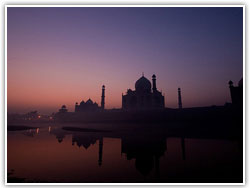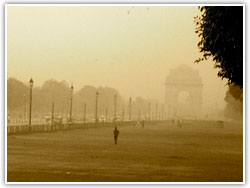|
|
History of North India
.............................................................................................................................................................................. |
|
|
|
Punjab was part of the Indus
Valley civilization which then spread southwards
along the western seaboard and eastwards to the
Ganga. Some of the Harappan cities now in North
India had trade links with Egypt and Mesopotamia.
A Harappan dry dock has been excavated at the
Harappan port of Lothal in Gujarat. The Harappan
people were followed – perhaps sven swept away –
by the invading Aryans, their onslaught like a
hurricane: a people who had never known a city
according to a Mesopotamian chronicler. As the
Aryans |
 |
|
|
settled to an agricultural way of
life new religious ideas and practices began to take
shape. Indigenous tribes were displaced and retreated to
the remoteness of the hills and forests. Well-wooded
Madhya Pradesh still has a significant tribal population
of which the Gonds are the most numerous. Kausambi in
Uttar Pradesh dates from the 8th century BC, when the
Aryans had taken up farming. By this period the early
Vedas were already written down, and the upper plains of
the Ganga had become the hearth of what was to become
modern Hindu civilization. This was the setting for the
classics of Sanskrit literature.
Small communities of Greek origin
settled in the Punjab and Northwest Frontier following
Alexander’s invasion of 326 BC. Owing to his untimely
death in 323 BC, arrangements to annex the Indian
provinces proved fruitless. At Vidisha (MP) there is the
2nd century Heliodorus votive pillar named after the
Greek who had settled in India and become a Hindu. At
this time many of the cities of N India where already
long-established.
The Gupta period (4th-6th centuries
AD), was the golden age of Hindu culture in N India. The
Guptas created an empire that stretched across northern
India from the Punjab to the Bay of Bengal and to a line
running from the Gulf of Cambay in Gujarat to Orissa.
The Chinese traveler and Buddhist pilgrim Fahien visited
India at the beginning of the 5th century and his
account gives a picture of India as a prosperous and
peaceful country. However, Hun invasions from the north
west contributed to the collapse of the Gupta Empire
which finally ended in 535 AD. Eighty years later a new
king, Harsha, inherited his father’s small kingdom at
Thanesar (Haryana) on the Upper Yamuna. The capital was
at Kannauj in Uttar Pradesh. By this time Buddhism was
already in decline. After Harsha’s death the region
lapsed in to a state of political anarchy. Kashmir
developed into a fairly strong kingdom whilst in
Rajasthan there arose a number of Hindu principalities.
Until the end of the 12th century, control of the region
was concentrated in the hands of the Hindu ruling
classes, of which the Rajputs are the best example. They
rose to political supremacy in the 9th and 10th
centuries and many of the Rajasthan dynasties trace
their origins to this period. Most authorities now
accepts that the Rajput clans were descended either from
the Huns who settled in North and West India during the
6th century AD, or from other Central Asian tribes who
accompanied the Huns. Though the Rajputs spanned a wide
range of social groups, they boasted a proud warrior
heritage and raised the concepts of loyalty, honour in
battle and bravery to the highest moral plane. The
Chandelas emerged as a strong regional power in Madhya
Pradesh and their fine temples at Khajuraho are evidence
of a period of enormous wealth.
|
| |
|
Mahmud of Ghazni, a local ruler from Afghanistan,
was attracted to India by its proverbial wealth
and the fertility of its lands. By launching
regular raids rather than full-scale invasions,
Mahmud financed his struggles in Central Asia.
Careful planning of the campaigns saw the arrival
of the Afghans in India during the harvest season.
The temples of N India, with their enormous wealth
in cash, golden images and jewellery, made them
natural targets for a non-Hindu. Mahmud’s
insatiable greed for gold was |
 |
|
|
complemented by his
religious motivation as an image-breaker. He sacked the
wealthy centres of Mathura in 1017, Thanesar in 1011,
Somnath in 1024 and Kanauj. Mahmud died in 1030 but in
spite of him, India did not become more aware of the
world to the NW. Defence remained purely local, its
purpose to defend one king against another.
The Rajput clans returned to their battles against each
other in the 11th and 12th centuries. In the late 12th
century Muhammad Ghuri attacked the plains. Entering
India by the Gomal Pass near Bannu in Pakistan, by 1191
he had overrun the former Ghaznavid (after Mahmud of
Ghazni) dependencies in the Punjab and acquired the
suzerainty of Arab Sind. Muhammad was thinking in terms
of establishing a kingdom rather than indulging in
periodic raids and this brought Rajput chivalry a fresh
challenge. At Taraori on the Panipat plain N of Delhi,
the Rajputs gathered together as best they could, won a
first battle, but were only able to hold off the Muslim
threat for a year. In 1192 a second battle was fought in
the same place, the Hindu commander Prithviraj was
defeated and the kingdom of Delhi fell to the invaders.
Muhammad pressed on and took Ajmer in Rajasthan. In 1206
he was assassinated, but this did not herald a general
withdrawal. Muhammad had been determined to retain his
Indian acquisitions and this policy was followed to by
his successors.
The early rulers of what came to be called to the Delhi
Sultanate and a large number of their followers were
Turks, mainly from Central Asia, who had settled in
Afghanistan. The armies with which they invaded India
consisted of Turkish, Afghan and Persian mercenaries.
The majority were probably Afghan. The Ghuri (after
Muhammad of Ghur) kingdom did not last long after the
Muhammad's death but the Indian part of his kingdom
became the nucleus of a new political entity – the Delhi
Sultanate. Control passed to his slave governor, Qutb–ud–din–Aibak
even handed policy of conciliation and patronage in
Delhi he converted the Old Hindu stronghold of Qila Rai
Pithora into his Muslim capital and commenced a number
of magnificent building projects, the Quwwat-ul-Islam
mosque and the Qutub Minar, a victory tower.
The forces of the Delhi Sultanate were patently in
disarray. The Hindus were not in much better shape. All
over the N they had lost power. Many were forced into
the Himalayas, where they formed ‘Pahari’ (Hill)
kingdoms, for example in Garhwal, Chamba and Kangra.
Only in Rajasthan had they held out, but here they were
deeply divided by clan rivalry. In the Deccan they had
given way to the Bahmanis, whilst in the S the hold of
the Vijayanagar empire was more precarious than it
seemed. Everywhere division met the eye and India was
ripe for the picking. Just as it had been before the
first Muslim onslaught. The family character had changed
since Timur’s day. They also inherited from their
gruesome ancestor a liking for learned men and a passion
for beautifying their capital cities. Where his ambition
was to terrify the world, theirs seemed more to impress
it. Where he brought destruction to Delhi, they gave
Muslim India one of its periods of greatest splendour.
With magnificent buildings such as the Red Forts at Agra
and Delhi, Humayun’s Tomb in Delhi, the Itmad-ud-Daula
and Taj Mahal tombs at Agra, Akbar’s beautiful new
capital at Fatehpur Sikri, Jahangir’s pleasure gardens
in Kashmir, the pavilions and mosques at Ajmer in
Rajasthan. |
|
|
|
The Gurkha Wars of the early 19th century saw the
inclusion of Garhwal and Kumaon in Uttar Pradesh
and what is now Himachal Pradesh, into the
territory of the East India Company. The Sikhs had
developed as a strong regional power with a
vigorous new religion in the Punjab and during the
18th century, tore free of the Mughals and
established their own empire under Ranjit Singh.
Ultimately they came into conflict with the
British but, once beaten, proved loyal subjects.
The British advance up the Ganga |
 |
|
|
saw the
formal absorption of princely states into the Company’s
territories or the indirect control of those who
remained independent. Oudh was annexed under dubious
circumstances and its capital Lucknow was one of the
centres in which the flames of Indian discontent were
fanned when the Mutiny broke in 1857. kanpur and Lucknow
in Oudh, Meerut, Delhi and Jhansi were the scenes of
desperate struggles. Afterwards, the British, shaken by
the experience, adopted a more conciliatory attitude
towards Indians. The railway system was rapidly expanded
during this period, linking regions together
economically, enabling the rapid movement of vital
supplies during famines and other times of crisis. It
also gave Indian’s an hitherto unknown mobility. Canals
permitted the irrigation of larger areas of the Gangetic
plain and the Punjab.
Hill stations developed as a means by
which the overheated Europeans could cool off during the
stiflingly hot summer months. Along the length of the
Himalaya, at an average altitude of around 2,000 m,
summer resorts emerged. The Himalayan stations include
Nainital, Mussoorie and Ranikhet in Uttar Pradesh and
Shimla, Dalhousie and Dharamshala in Himachal Pradesh.
The Mughals had already developed Kashmir but Pahalgam
and Gulmarg were also popularized. Mount Abu catered to
residents of Rajasthan and Pachmarhi to those in Madhya
Pradesh. Government escaped from hot and sticky cities
of Calcutta or Delhi to the cool breezes of Shimla, over
1,500 km away. In May government officers, wives and
servants went up to the summer capital. In September
they all came down again. In 1911 the capital was
transferred to Delhi, which naturally meant that the N
became the focal region of India. To mark the change
another new city was built. New Delhi is the extravagant
work of Britain’s empire builders. In fact, within 15
years of the new city’s completion the British Indian
Empire came to an end.
Independence came after a remarkable struggle initially
orchestrated by Mahatma Gandhi and waged in the best
principles of Jainism and Buddhism, through
non-violence. The Partition of India along religious
lines, however, let loose a violence which was often
uncontrollable. The transfer of power and boundary
delineation resulted in a broken Punjab and a horrible
episode of fear and brutality as millions attempted to
relocated to their chosen country. Independence saw the
redrawing of state boundaries along linguistic grounds,
the extension of the Panchayat Raj over village
administration and the emphasis in the first Five year
Plans on industrialization. |
|